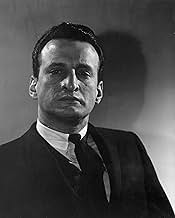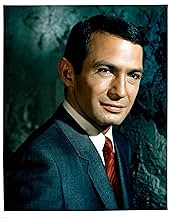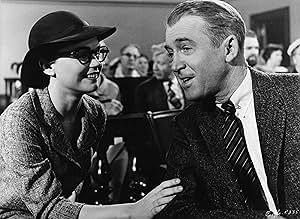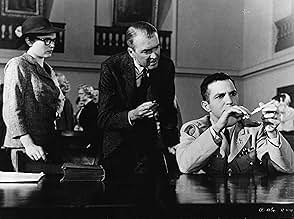Jugé pour meurtre, Frederick Manion avoue avoir souffert de folie passagère après que la victime ait violé sa femme.Jugé pour meurtre, Frederick Manion avoue avoir souffert de folie passagère après que la victime ait violé sa femme.Jugé pour meurtre, Frederick Manion avoue avoir souffert de folie passagère après que la victime ait violé sa femme.
- Réalisation
- Scénario
- Casting principal
- Nommé pour 7 Oscars
- 10 victoires et 18 nominations au total
Avis à la une
The legendary James Stewart has worked for several of Hollywood's most legendary directors including Frank Capra and Alfred Hitchcock but his films for them can not reach the level of this 1959 Columbia Pictures release that he did for Otto Preminger. Stewart gives his all time greatest performance in a gem of a courtroom drama that is often overlooked. Released on the heels of several other courtroom drama classics such as "Twelve Angry Men" and "Witness For The Prosecution", "Anatomy Of A Murder" tells the story of a small town Michigan lawyer (Stewart) who takes on the case of an army officer who is standing trial for murdering a man who he believes had raped his wife. A little risque and controversial for its time but still a classic and time has served it well. A triumph for all of the talent involved.
I have tried more cases than I can remember - hundreds. This movie, more than any other, comes closet to real life.
In criminal cases., the first and most important thing is - the phone call. That's right, getting the case.
Next comes the 'talk.' An attorney has to inform the client of the possible outcomes given the facts. In Anatomy of a Murder, the main facts are 'undisputed', that is, there is no doubt that the defendant killed the victim.
Given that fact, there are only so many possible defenses - and so Jimmy Stewart, in one of the best performances of his career, relates those defenses to Ben Gazzara, in one of his best performances.
Along the way, we are treated to George C. Scott's premiere performance on screen - and it is is magnificent.
Did I mention how incredible and sexy and vulnerable Lee Remick is?
And the rest of the cast is also as good as it gets.
And then there's the Duke Ellington score (he won a Grammy) and the Wendell Mayes screenplay and the B/W cinematography by Sam Leavitt (The Defiant Ones (Oscar-winner), A Star is Born (1954)).
Watch this movie to see how to make a crime drama. There is nothing as good as it is - nothing.
Anatomy of an excellent movie:
Begin with an extremely tight and well written script, from the novel by the same name. While reportedly the story is based on a real-life case it is nevertheless a timeless story, almost biblical, presenting age-old questions of human conflicts and human dilemmas.
Add to that a sensational cast, starting of course with the leads, Jimmy Stewart, George C. Scott, Lee Remick, and Ben Gazarra, but also the rest of the cast, filled as it is with numerous accomplished and veteran stage actors and radio performers from days of yore. Character parts played by actors Arthur O'Connell, Eve Arden, Ken Lynch, Joseph Kearns, and Howard McNear. Someone paid careful attention to the casting for this film.
Perhaps the most masterful stroke as far as casting goes was the casting Joseph Welch as the judge. Welch was an experienced and renowned lawyer in real life. Welch turns in a very good and a very believable performance.
With the collision of those elements, a great script and a great cast, adding Otto Preminger as director, an overseer who knew exactly what to do with it all, you then have a very fine film.
More than any other movie or play, including modern day presentations like the television series Law & Order, this 1959 movie, Anatomy of a Murder, even though it is now 46 years old, is by far the most realistic and technically accurate courtroom drama ever produced. The conduct of the trial, the examination of the witnesses, the colloquy and bantering back and forth between the lawyers and between the lawyers and the judge, is spot-on. Every bit of it. Every question from the lawyers, every objection, every ruling by the judge, every admonishment from the judge, and the testimony of the witnesses, every bit of it, is realistic and believable, lines that were accurately written with care, and then flawlessly delivered.
Beyond the technical accuracies of the legal proceedings, some other aspects of the overall story were also spot on. The ambiguous ambivalence of lawyers, their motivations, their ethics, their relative honesty. Nothing is all black or all white. Shades of gray abound. Legal cases as sport. Being a "good lawyer" means pushing the envelope too far, bending the rules until you're told to stop. Not for justice. No, not that. To win. That's why. To win. Then sanctimoniously telling themselves that the system really works better this way. The movie accurately captures the fact that real-life legal cases are very often comprised of upside down Alice in Wonderland features. Innocent people are guilty, and guilty people are innocent. Good is bad, and bad is good. Everything is relative. Some call it cynicism. Others, cynically, call it realism. Anatomy of a Murder captures all of these and more.
I've read the criticism that Lee Remick was not believable, that as an actress she failed at nailing the portrayal of how a true rape victim would appear and behave, and that her character, Laura Manion, just didn't seem to have the proper affect nor strike the right emotional chord of a woman who had been raped. All I can say is that such criticism misses a humongous part of the point. It is almost mind-boggling that there are viewers out there who, after viewing this film, somehow managed to miss it. Let me clear it up: we the viewers WERE SUPPOSED to have serious doubts about whether Laura Manion had actually been raped. The question of whether she was really raped or not is central to the plot and story line. That's why Lee Remick played the part the way she did. And then, in turn, it was part of the story for the Jimmy Stewart character, Paul Biegler, to recognize this problem, and the problem that it presented to his defense. He worried that the jury would see it and would also doubt that she had been raped, and so that's why he propped her up in court, dressed up all prim and proper, with a hat over her voluptuously cascading hair, and with horned-rim glasses. So, yes, Lee Remick nailed it. Bull's eye.
Speaking of Lee Remick, some say that this was the movie that put Lee Remick on the map. She was stunningly beautiful here, at the ripe young age of 24. Even though the film is in black and white, her red hair, blue eyes, and porcelain skin still manage to jump right off the screen and out at you. Has any other actress ever played the role of the beautiful and sexy lady looking to get laid any better than Lee Remick? It was a woman she reprised several times in her career, sometimes with greater subtlety and understatement than others. This was her first rendition of it, and it may have been the best.
Anatomy of a Murder is a very complex movie, with multitudes of layers and texturing, where much is deftly explored, but precious little is resolved. It's a movie that leaves you thinking and wondering. I highly recommend it.
Begin with an extremely tight and well written script, from the novel by the same name. While reportedly the story is based on a real-life case it is nevertheless a timeless story, almost biblical, presenting age-old questions of human conflicts and human dilemmas.
Add to that a sensational cast, starting of course with the leads, Jimmy Stewart, George C. Scott, Lee Remick, and Ben Gazarra, but also the rest of the cast, filled as it is with numerous accomplished and veteran stage actors and radio performers from days of yore. Character parts played by actors Arthur O'Connell, Eve Arden, Ken Lynch, Joseph Kearns, and Howard McNear. Someone paid careful attention to the casting for this film.
Perhaps the most masterful stroke as far as casting goes was the casting Joseph Welch as the judge. Welch was an experienced and renowned lawyer in real life. Welch turns in a very good and a very believable performance.
With the collision of those elements, a great script and a great cast, adding Otto Preminger as director, an overseer who knew exactly what to do with it all, you then have a very fine film.
More than any other movie or play, including modern day presentations like the television series Law & Order, this 1959 movie, Anatomy of a Murder, even though it is now 46 years old, is by far the most realistic and technically accurate courtroom drama ever produced. The conduct of the trial, the examination of the witnesses, the colloquy and bantering back and forth between the lawyers and between the lawyers and the judge, is spot-on. Every bit of it. Every question from the lawyers, every objection, every ruling by the judge, every admonishment from the judge, and the testimony of the witnesses, every bit of it, is realistic and believable, lines that were accurately written with care, and then flawlessly delivered.
Beyond the technical accuracies of the legal proceedings, some other aspects of the overall story were also spot on. The ambiguous ambivalence of lawyers, their motivations, their ethics, their relative honesty. Nothing is all black or all white. Shades of gray abound. Legal cases as sport. Being a "good lawyer" means pushing the envelope too far, bending the rules until you're told to stop. Not for justice. No, not that. To win. That's why. To win. Then sanctimoniously telling themselves that the system really works better this way. The movie accurately captures the fact that real-life legal cases are very often comprised of upside down Alice in Wonderland features. Innocent people are guilty, and guilty people are innocent. Good is bad, and bad is good. Everything is relative. Some call it cynicism. Others, cynically, call it realism. Anatomy of a Murder captures all of these and more.
I've read the criticism that Lee Remick was not believable, that as an actress she failed at nailing the portrayal of how a true rape victim would appear and behave, and that her character, Laura Manion, just didn't seem to have the proper affect nor strike the right emotional chord of a woman who had been raped. All I can say is that such criticism misses a humongous part of the point. It is almost mind-boggling that there are viewers out there who, after viewing this film, somehow managed to miss it. Let me clear it up: we the viewers WERE SUPPOSED to have serious doubts about whether Laura Manion had actually been raped. The question of whether she was really raped or not is central to the plot and story line. That's why Lee Remick played the part the way she did. And then, in turn, it was part of the story for the Jimmy Stewart character, Paul Biegler, to recognize this problem, and the problem that it presented to his defense. He worried that the jury would see it and would also doubt that she had been raped, and so that's why he propped her up in court, dressed up all prim and proper, with a hat over her voluptuously cascading hair, and with horned-rim glasses. So, yes, Lee Remick nailed it. Bull's eye.
Speaking of Lee Remick, some say that this was the movie that put Lee Remick on the map. She was stunningly beautiful here, at the ripe young age of 24. Even though the film is in black and white, her red hair, blue eyes, and porcelain skin still manage to jump right off the screen and out at you. Has any other actress ever played the role of the beautiful and sexy lady looking to get laid any better than Lee Remick? It was a woman she reprised several times in her career, sometimes with greater subtlety and understatement than others. This was her first rendition of it, and it may have been the best.
Anatomy of a Murder is a very complex movie, with multitudes of layers and texturing, where much is deftly explored, but precious little is resolved. It's a movie that leaves you thinking and wondering. I highly recommend it.
... since part of the allure is the mystery as to whether or not a true murder has been committed in the first place. There is a killing - but is it murder? That is what this courtroom drama is trying to determine.
Paul Biegler (James Stewart) is a country lawyer in Michigan who was once the local DA but must have lost reelection at some point. He seems to consider himself pseudo-retired, as he stays in just enough contract work to finance his true love - fishing. But then a lieutenant in the army (Ben Gazzara as Fred Manion) kills the man who raped his wife (Lee Remick as Laura Manion), is charged with murder, and Biegler has a big case on his hands.
Manion is a bit shifty - At first claiming he has the "unwritten law" on his side. But then when Biegler tells him there really is no such thing, Manion adjusts his story such that temporary insanity could be a plausible defense.
The truth is, it never is clear which was true - Did Manion truly temporarily lose it when he saw his wife brutalized by a rapist, or did Laura Manion get cold busted by her husband stepping out with another man with the result being that Lt. Manion lost his temper and killed the other man? Gazzara plays his part as arrogant and Remick plays her part as flirty, each shooting the other looks at various points that indicate they are keeping at least part of the truth to themselves. What keeps it interesting are the characters, the emphasis on the legal process, and the question I just posed that hangs over the entire proceedings. Although everyone is good, the judge is an absolute understated scream. You can tell he doesn't like having this high profile case in his courtroom, that like Biegler he'd rather be fishing, but he has a job to do and he'll do it fairly. Joseph Welch played the part of the judge, and the fact that he was actually an attorney gives the performance the needed authenticity.
James Stewart was supposed to star in "North By Northwest" in 1959, but Hitchcock was angry at him because Vertigo had been a commercial failure, calling Stewart too old. He then dumped Stewart for Cary Grant so that Stewart was available to do this film. In the end, everything worked out. All three films are now recognized classics, and I can't see anybody but Stewart with his folksy charm playing the lead in this film.
Paul Biegler (James Stewart) is a country lawyer in Michigan who was once the local DA but must have lost reelection at some point. He seems to consider himself pseudo-retired, as he stays in just enough contract work to finance his true love - fishing. But then a lieutenant in the army (Ben Gazzara as Fred Manion) kills the man who raped his wife (Lee Remick as Laura Manion), is charged with murder, and Biegler has a big case on his hands.
Manion is a bit shifty - At first claiming he has the "unwritten law" on his side. But then when Biegler tells him there really is no such thing, Manion adjusts his story such that temporary insanity could be a plausible defense.
The truth is, it never is clear which was true - Did Manion truly temporarily lose it when he saw his wife brutalized by a rapist, or did Laura Manion get cold busted by her husband stepping out with another man with the result being that Lt. Manion lost his temper and killed the other man? Gazzara plays his part as arrogant and Remick plays her part as flirty, each shooting the other looks at various points that indicate they are keeping at least part of the truth to themselves. What keeps it interesting are the characters, the emphasis on the legal process, and the question I just posed that hangs over the entire proceedings. Although everyone is good, the judge is an absolute understated scream. You can tell he doesn't like having this high profile case in his courtroom, that like Biegler he'd rather be fishing, but he has a job to do and he'll do it fairly. Joseph Welch played the part of the judge, and the fact that he was actually an attorney gives the performance the needed authenticity.
James Stewart was supposed to star in "North By Northwest" in 1959, but Hitchcock was angry at him because Vertigo had been a commercial failure, calling Stewart too old. He then dumped Stewart for Cary Grant so that Stewart was available to do this film. In the end, everything worked out. All three films are now recognized classics, and I can't see anybody but Stewart with his folksy charm playing the lead in this film.
Well filmed, beautifully acted, and painstakingly directed, this film deserves the highest praise.
James Stewart brings his customary stammering, quirky charm to a role that could have easily become overwhelmingly serious. Lee Remick is seen establishing her early image as the somehow fragile, undeniably seductive pawn (see also "A Face in The Crowd"), while Gazzara wavers intensely somewhere between heartless murderer and protective husband. The supporting cast is strong, creating a human backdrop for the senior players, keeping the story in the real world, effectively preventing this from becoming an exercise in legal theory.
This film is noteworthy for a myriad of reasons, but most specifically because it addresses the still controversial issue of acquaintance rape, and presents us with a victim of questionable morals. At the same time our murder victim is seen as a monster, then a friend and father. There really are no heroes here, no noble defenders, no pristine heroines, no completely innocent bystanders...both sides take their turns pointing fingers, each claiming that the other only got what they deserved.
We are forced to re-evaluate our thoughts on what constitutes justifiable homicide--the unwritten law that Manion speaks of in the film versus the law as written that Biegler must now interpret. This manipulation of intended meaning sets a somewhat tragic precedent evident in the legal system we work within today.
This film is highly entertaining, and excellent for discussion. Watch it with some of your more philosophical friends.
James Stewart brings his customary stammering, quirky charm to a role that could have easily become overwhelmingly serious. Lee Remick is seen establishing her early image as the somehow fragile, undeniably seductive pawn (see also "A Face in The Crowd"), while Gazzara wavers intensely somewhere between heartless murderer and protective husband. The supporting cast is strong, creating a human backdrop for the senior players, keeping the story in the real world, effectively preventing this from becoming an exercise in legal theory.
This film is noteworthy for a myriad of reasons, but most specifically because it addresses the still controversial issue of acquaintance rape, and presents us with a victim of questionable morals. At the same time our murder victim is seen as a monster, then a friend and father. There really are no heroes here, no noble defenders, no pristine heroines, no completely innocent bystanders...both sides take their turns pointing fingers, each claiming that the other only got what they deserved.
We are forced to re-evaluate our thoughts on what constitutes justifiable homicide--the unwritten law that Manion speaks of in the film versus the law as written that Biegler must now interpret. This manipulation of intended meaning sets a somewhat tragic precedent evident in the legal system we work within today.
This film is highly entertaining, and excellent for discussion. Watch it with some of your more philosophical friends.
Le saviez-vous
- AnecdotesPart of the controversy surrounding this movie was because it included use of the words "bitch", "contraceptive", "panties", "penetration", "rape", "slut", and "sperm".
- GaffesJames Stewart goes to negotiate with the DA at the courthouse. Sign over the DA's door is misspelled "Proseguting attorney". Actually this is not true. It's possible to compare the c with the g at the end of the word, and you can see the g has a descending stroke. It's just a foible of the font.
- Citations
Paul Biegler: As a lawyer, I've had to learn that people aren't just good or just bad. People are many things.
- ConnexionsFeatured in Portrait of an Actor (1971)
Meilleurs choix
Connectez-vous pour évaluer et suivre la liste de favoris afin de recevoir des recommandations personnalisées
Détails
- Date de sortie
- Pays d’origine
- Langue
- Aussi connu sous le nom de
- Anatomía de un asesinato
- Lieux de tournage
- Tripoli Bar, Ishpeming, Michigan, États-Unis(interiors: Thunder Bay Inn)
- Société de production
- Voir plus de crédits d'entreprise sur IMDbPro
Box-office
- Montant brut mondial
- 194 $US
- Durée
- 2h 41min(161 min)
- Couleur
- Mixage
- Rapport de forme
- 1.85 : 1
Contribuer à cette page
Suggérer une modification ou ajouter du contenu manquant







































